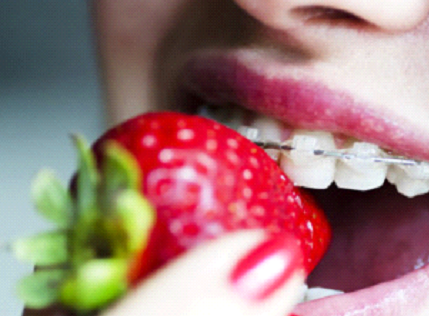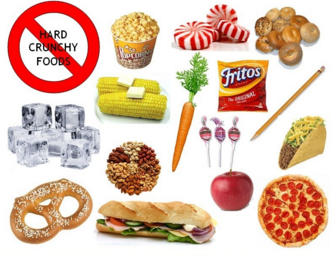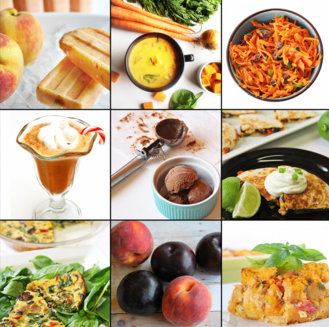After your braces are put in place and any routine adjustments are complete, you are likely to feel some temporary pain, soreness and discomfort. This will diminish after about a week. However, before you can start enjoying some of the foods you love, you will need to know how to eat with braces to avoid the foods that could damage your new appliances.

How to Eat With Braces
Avoid Hard Food
Hard foods may crack your braces, and cause you some pain in the days following an installation or adjustment of your braces. Try to avoid hard foods such as:
Hard rolls, pizza crust, bagels, pretzels, raw carrots, and nuts
Corn chips and tacos, as they can leave hard to remove debris in the hardware
Tough meats like beef jerky, which can loosen the brackets and wires
Sticky or gummy foods, like gum, caramel, jelly beans, candy, and taffy that can pull apart and damage the braces
Ice: Chewing ice is one of the easiest ways to damage the braces
Non-food items like pencils and pens, because they can also cause damage to the appliance
Eat Soft Foods
This means eating foods that are gentle on the wires and brackets that hold your braces together and in place. Non-chewy soft foods are best because not only are they less likely to damage the appliance, they are less likely to cause you any pain. Try eating soft foods such as:
Meats and poultry - ground beef, soft cooked chicken, and luncheon meats
Seafood - baked or broiled fish fillets, salmon, tuna, and crabmeat
Grains – pasta, noodles, or steamed rice
Vegetables - mashed potatoes, yams, steamed spinach, peas, and beans
Breads – sliced bread, pancakes, soft tortillas, muffins with no nuts, and biscuits
Fruits - bananas, applesauce, and fruit juice
Dairy - soft cheeses, and puddings
Other – eggs, hot dogs, chili, and stews
Treats - ice cream (no nuts), milkshakes, cake, smoothies, and gelatins
Change Your Eating Habit
Make the Food Smaller
Eating foods the way you're used to could cause brackets to come off your teeth or break altogether. Learning how to eat with braces doesn’t mean you have to give up on the foods you like. For example, if you love corn on the cob simply use a knife to cut corn kernels off the cob. Cut apples into slices before eating, instead of biting and pulling with your front teeth, and a good way to avoid any damage is by cutting all your food into smaller pieces.
Chew With Your Back Teeth
When you've recently had braces put on, chew with your back teeth. They are better suited for grinding food, and may help alleviate the pain your front teeth might be feeling. It can be helpful to physically put the food in the back of your mouth. If you're not used to using a fork to place food in the back of your mouth, try placing the food pieces into the back of your mouth using your fingers.
Don’t Rush When You Eat
Eating too quickly could cause you to forget how to eat with braces such as eating smaller pieces, and chewing with your back teeth. If you eat too quickly, you may also risk biting into pits, seeds, or bones. Drink plenty of water while you’re eating. This makes swallowing easier if you're having a hard time chewing. Drinking water also helps rinse away any food residue that may get caught in your braces.
How to Take Care of Your Teeth When Wearing Braces
Use Saline to Rinse Your Mouth
The most common way to reduce inflammation in your mouth is by rinsing with a saline solution made from a teaspoon of salt and eight ounces of clean, warm water. Rinse with the saline solution as often as necessary, but especially for the first week after an installation or adjustment.
Apply Wax on the Wires and Appliances
Some people may experience discomfort from the metal on the braces as it rubs the flesh, while others may have to deal with a protruding wire, the remedy is to apply orthodontic wax on the wires and appliances. Orthodontic wax helps you adjust to the metal braces that are causing the discomfort and pain. However, if you have a broken bracket or a poking wire, it's best to see your orthodontist as soon as possible.
Brush Teeth Thoroughly
Use a toothbrush with soft bristles and a small strip of fluoride toothpaste. When you brush your teeth, move the brush in small circular motions and brush carefully and slowly, covering all areas between braces, between teeth, including the surface of each tooth. Brush down on the upper teeth and up on the lower teeth, and remember to brush your tongue and the roof of your mouth before rinsing.
It is important when learning how to eat with braces to brush your teeth four times daily to avoid the accumulation of food particles in your teeth and braces. Orthodontists recommend you brush:
After breakfast
After lunch or early afternoon
After dinner
At bedtime
Remember to replace your toothbrush with a new one as soon as the bristles start to wear down.
Floss Teeth Daily
Flossing will take more time and patience when you are wearing braces. Be careful around your arch wire and do not floss too hard around it or put a lot of pressure on it. After you floss between your braces, floss between your other teeth and gums and behind all of your back teeth. Floss at night to ensure your teeth are clean before bedtime. Take note that when you first begin flossing around your braces, your gums may bleed a little. If the bleeding does not stop after the first few times, inform your orthodontist at your next appointment.



View All Comments /Add Comment